#coma galaxy cluster
Explore tagged Tumblr posts
Text
Deep look into the past


This picture of the constellation of Coma Berenices isnt very spectacular on first glance. But within this constellation lays the Coma galaxy cluster, a group of 1000 Galaxies each with millions .... billions of own stars.
Most of those galaxies are roughly 300 Million lightyears away ... a distance hard to process for the human mind.
In the second picture each galaxy visible is marked in red or blue depending on the catalog it registered in. Who wanna count them? Who wanna guess on how many civilization we are looking at?
Bilddaten:
- RGB 63 x 300s / Gain 100
- 25 Flat Dark
- 25 Flat Darks
- 25 Darks
Setup:
- Skywatcher 150/750 PDS
- Omegon 571C
- Skywatcher EQ6R Pro
- Zwo Asi 178mm
#astronomy#universe#space#space photography#astrophotography#night sky#astrophysics#nature#coma galaxy cluster
237 notes
·
View notes
Text
It occurred to me that since I was last on Tumblr, I got a new astrophotography setup. I've only used it a few times, but most nights I'd rather haul out Lyra the Dob for a quick and easy setup.
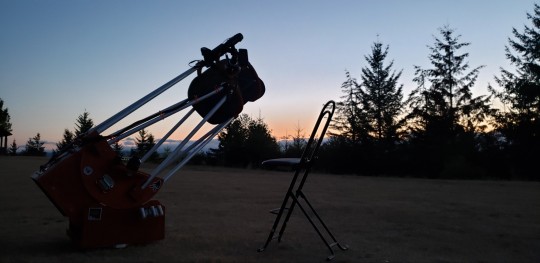
The scope part of the new rig arrived the day before I left for a week-long trip to dark skies as a mentor at an astronomy camp. I got the go-ahead to bring it; the seeing was bad all week so the stars were bloated, but I still had a great time.
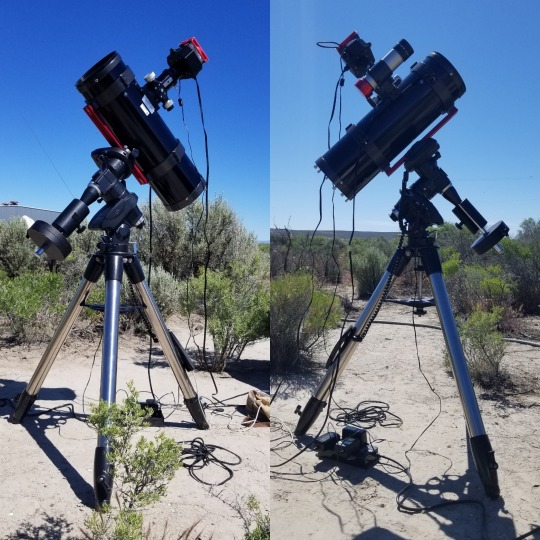
From that week:
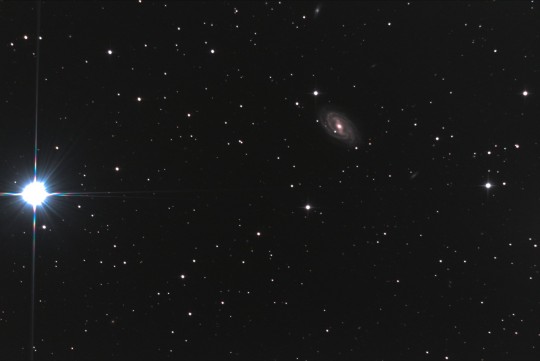
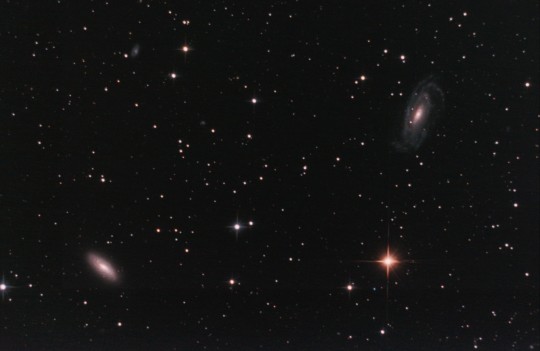
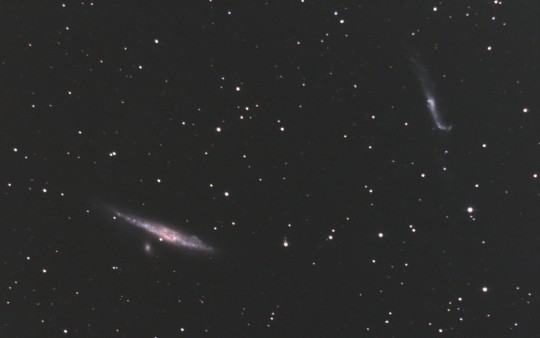
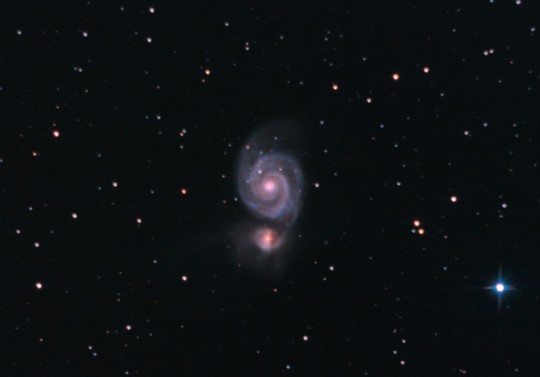
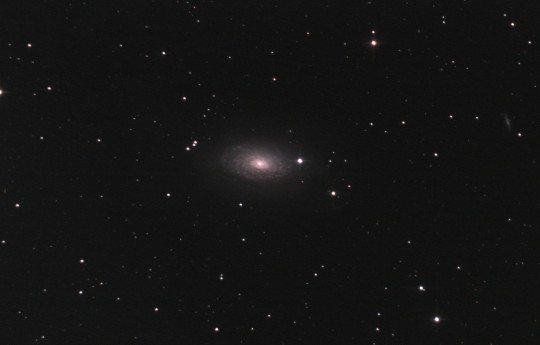

At top left is Messier 109; the bright star is the bottom-left corner of the Big Dipper's cup. I'd chosen it for first light because I'd never imaged it before and it has a beautiful barred spiral structure. In this cropped version you can see the structure and three faint satellite galaxies to the right, running in a row from above the galaxy to just below and right of it.

The one at bottom right is the Coma Galaxy Cluster. The seeing made it hard to tell, but *most* of the points of light in that image are individual galaxies and not stars. I could see a few dozen through my visual scope one night. It was glorious.
37 notes
·
View notes
Text

Lensed Seahorse
93 notes
·
View notes
Text

Thousands of Coma Cluster Galaxies - September 17th, 1995.
"Almost every object in the above photograph is a galaxy. The Coma Cluster of galaxies pictured is a dense cluster containing many thousands of galaxies. Many of these galaxies contain as many stars as our own Milky Way galaxy. Although nearby when compared to most other clusters, light from the Coma Cluster still takes hundreds of millions of years to reach us. In fact, the Coma Cluster is so big it takes light millions of years just to go from one side to the other! This picture was created at the WWW site Skyview, a "virtual observatory" where it is possible to view any part of the sky in wavelengths from radio to gamma-ray."
27 notes
·
View notes
Text
During the early 1930s, Fritz Zwicky, a professor of astronomy at the California Institute of Technology (a famously caustic scientist whose appreciation for symmetry led him to call his colleagues spherical bastards because, he explained, they were bastards any way you looked at them), realized that the outlying galaxies in the Coma cluster, a collection of thousands of galaxies some 370 million light-years from earth, were moving too quickly for their visible matter to muster an adequate gravitational force to keep them tethered to the group.
"The Fabric of the Cosmos" - Brian Greene
#book quotes#the fabric of the cosmos#brian greene#nonfiction#30s#1930s#20th century#fritz zwicky#astronomy#california institute of technology#caustic#bastard#galaxy#coma cluster#gravity
4 notes
·
View notes
Text
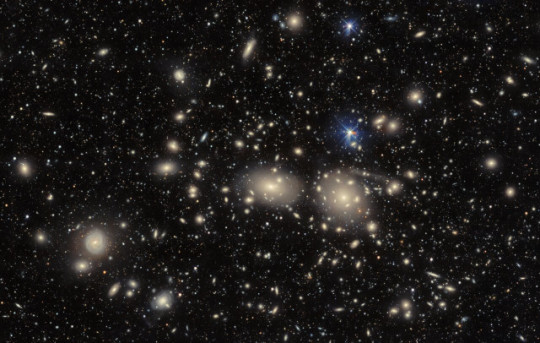
An image captured by the Dark Energy Camera (DECam) depicts the Coma Cluster, also known as Abell 1656, so named because it's part of the constellation Coma Berenices. DECam was designed to conduct a long-term investigation of dark energy but is also useful for other types of astronomical studies. The Coma Cluster is linked to the study of dark matter since the inconsistency between the estimate of its overall mass and the measurement of its gravitational effects stimulated the research that led to today's dark matter models.
0 notes
Text
DOES DARK MATTER REALLY EXIST??
Blog#473
Wednesday, January 22nd, 2025.
Welcome back,
In April 2023, scientists from the Atacama Cosmology Telescope (ACT) collaboration created a map of the universe showing the detailed distribution of dark matter, a mysterious form of matter that makes up around 85% of the total matter in the universe.
While creating any accurate map of matter distribution across the cosmos is an impressive feat, it is particularly extraordinary for dark matter, which does not interact with light and thus cannot be seen directly with telescopes or other instruments.

So, if dark matter is effectively "invisible," how can scientists map it? And how do we even know dark matter exists? Put simply, to detect dark matter, astronomers look at its indirect effects on gravity and how it impacts other objects with mass and light.
All galaxies are believed to be wrapped in an invisible halo of dark matter, and this envelope is vitally important; galaxies are rotating so rapidly, that without dark matter, they would have been torn apart long ago if they were held together only by the influence of their stars, gas, dust and planets, according to the European Organization for Nuclear Research (CERN).

As such, this mysterious substance must have played an important role in the evolution of the universe.
Everything we see around us on a day-to-day basis is made up of "ordinary" matter, known as baryonic matter, meaning it's composed of baryons (such as protons and neutrons). According to the Swinburne Centre for Astrophysics and Supercomputing, cosmic objects made of baryonic matter include clouds of cold gas, planets, comets and asteroids, stars, neutron stars and even black holes.

Most of these cosmic objects (as well as Earthbound objects, such as tables, cars and cats) can be seen because baryons interact with the electromagnetic force, one of the universe's four fundamental forces. When electromagnetic radiation, including visible light, falls on baryonic objects, they absorb photons and reemit them, or simply reflect them, so these objects can be seen. Even dark clouds of cosmic gas that do not shine brightly absorb photons of light at certain wavelengths, so they can be seen by their interaction with light.

Scientists know that dark matter is distinct from ordinary baryonic matter because whatever particles dark matter comprises either don't reflect, absorb or emit electromagnetic radiation or if they do interact with light, they do so incredibly weakly. This means dark matter can't be seen in traditional ways that rely on electromagnetic radiation.
Although dark matter does not interact strongly via electromagnetism, it does interact with another fundamental force: gravity. It is through the interaction with gravity that astronomers were first able to discover dark matter and, later, accurately map it.

The first hints of dark matter were observed in 1933 when California Institute of Technology astronomer Fritz Zwicky used the Mount Wilson Observatory to measure the visible mass of the Coma Cluster of galaxies. Zwicky, later dubbed "the father of dark matter," found that single galaxies in this cluster were moving too fast for the cluster to remain together based on the gravity of the visible matter alone.
Zwicky suggested that an as-yet-unobserved type of mass — "dunkle Materie," or "dark matter" — might explain this disparity, but the concept wouldn't be widely accepted for decades to come, until after his death in 1974.

While studying the rotational dynamics of galaxies, Carnegie Institution astronomer Vera Rubin became the next scientist to infer the presence of dark matter with observations that helped to cement it as an accepted element of the universe. Rubin saw that the stars at the edge of spiral galaxies far from their dense centers were moving as fast as stars closer to the galactic heart, according to the American Museum of Natural History.
Originally published on https://www.space.com
COMING UP!!
(Saturday, January 25th, 2025)
"WHAT ARE DARK STARS??"
#astronomy#outer space#alternate universe#astrophysics#universe#spacecraft#white universe#space#parallel universe#astrophotography
63 notes
·
View notes
Photo

2024 May 2
M100: A Grand Design Spiral Galaxy Image Credit & Copyright: Drew Evans
Explanation: Majestic on a truly cosmic scale, M100 is appropriately known as a grand design spiral galaxy. The large galaxy of over 100 billion stars has well-defined spiral arms, similar to our own Milky Way. One of the brightest members of the Virgo Cluster of galaxies, M100, also known as NGC 4321 is 56 million light-years distant toward the well-groomed constellation Coma Berenices. In this telescopic image, the face-on grand design spiral shares a nearly 1 degree wide field-of-view with slightly less conspicuous edge-on spiral NGC 4312 (at upper right). The 21 hour long equivalent exposure from a dark sky site near Flagstaff, Arizona, planet Earth, reveals M100's bright blue star clusters and intricate winding dust lanes which are hallmarks of this class of galaxies. Measurements of variable stars in M100 have played an important role in determining the size and age of the Universe.
∞ Source: apod.nasa.gov/apod/ap240502.html
91 notes
·
View notes
Text
Why Does the Ortolan Sing?
A human AU Good Omens fanfic

(View uncensored art on AO3)
Chapter 20: So Much For Stardust
Rating: Explicit
Summary:
Following his mother’s death, Azira sets out to prepare his family’s bookshop for reopening. While appreciating the shop’s new sign, he hears the beckon of a siren’s song sounding from the coffee shop over the road. He succumbs to temptation to find the source of the hypnotic voice is an auburn-haired songbird. Intrigued by the singer’s beauty and haunted by his apparent loneliness, Azira is determined to introduce himself. There’s only one problem: the musician’s menacing, jealous, and possessive partner.
CW: Domestic abuse, loss of a loved one, adultery, toxic relationship, murder, blood, organized crime
Excerpt from chapter 20:
“Space is incredible, you know?” Crowley’s smile broadened as he stared up at God’s canvas. “It’s true eternity. So vast and limitless, we’re constantly finding something new. Even when Earth is long gone, the space we used to occupy will receive the light from star systems we’ve never known, never named, and the light from Earth will do the same. We’re fleeting, but space isn’t.”
“That’s beautiful…” Azira sighed. “And slightly tragic. Nothing lasts forever, I suppose.”
“Some things do.” Crowley took a deep breath of the fresh, country air. “Humans give names and stories to the stars, and I wonder who else out there, seeing the same stars from a different angle, have done the same. Like over there,” Crowley motioned to a cluster of stars Azira couldn’t differentiate from any others. “Coma Berenices. Humans looked at those stars and saw the hair of an Egyptian queen, sacrificed to Aphrodite to ensure her husband’s return from battle. Something so human. Or the Andromeda Galaxy… one of our neighbors. Named for a beauty whose parents angered the Gods, causing her to be sacrificed to a monster. The stories we assign them won’t last for eternity, but their light always reaches somewhere, even once they’re gone. And there’s an infinite number of them to do just that.”
“When you put it like that, eternity is… a hard concept to grasp.” Azira pondered for a moment. He’d had philosophical conversations with his parents, but eternity was never a topic they touched on. “I admit, my mind usually stays grounded in the stories in books; I don’t tend to consider just how insignificant that all is.”
Crowley eyed Azira at askance, then rolled onto his side, propping his head up on his hand and smiling. “Eternity is a mountain made of diamonds.”
“A what?” Azira grinned.
“There’s a mountain made of diamonds, a hundred miles wide and a hundred miles high, and every thousand years a bird comes and sharpens its beak on the mountain.”
“The same bird?”
Crowley waved his hand dismissively. “We’re talking diamond mountains; you want to harp on the age of the bird?”
“Right,” Azira chuckled. “Carry on.”
“So this bird sharpens its beak on the mountain, scraping away a tiny piece every time. Once that mountain has completely worn away, one second of eternity has passed.”
Azira stared up at Crowley, his face framed in the falling stars and glittering diamonds of eternity, sending their light to Earth. His lips parted, a soft gasp leaving him as he took in the eternal beauty, incomparable in his mind to the fleeting beauty that was Crowley. Crowley’s soft smile and gentle eyes were gazing at him with the kind of love actors attempt to portray in movies. It was so believable, as he watched the old black-and-whites with his mother, until he witnessed it himself.
“Make love to me under the stars,” Azira whispered. “Eternally.”
Continue from chapter 20 here.
Thank you so much to everyone at @goodomensafterdark for your help and putting up with my millions of questions! 🥰
40 notes
·
View notes
Photo

The Coma Cluster of Galaxies
Credits: U. Toronto, Kitt Peak National Obs.
53 notes
·
View notes
Text
went out with my telescope tonight and got pictures of the black eye galaxy and the ring nebula :3


the black eye galaxy is a spiral galaxy about 17 million light years away, with an inner disk dense with dark dust that gives it its name
the ring nebula is a planetary nebula about 2500 light years away. planetary nebulae form when a red giant star at the end of its life sheds its outer layers into space, leaving a roughly spherical nebula with the star's remnant core as a tiny white dwarf in the center. our sun will share a similar fate billions of years from now
these two pictures kinda illustrate an interesting thing - the density of stars in them are drastically different. the black eye galaxy is located near the north galactic pole in the constellation coma berenices, so when you look towards it, you're looking "up" out of our galaxy. there's not too many stars in the way. this gives us a clear view of distant galaxies, and is why coma berenices and other nearby constellations (like canes venatici, ursa major, leo, and virgo) have soooooo many visible galaxies. the ring nebula on the other hand is located close to the galactic plane, which is very dense with stars. that plus the vast dust clouds in the galactic disk obscure our view of distant galaxies. instead we see things like star clusters and nebulae
31 notes
·
View notes
Text

Hubble takes a look at tangled galaxies MCG+05-31-045
This NASA/ESA Hubble Space Telescope image depicts the cosmic tangle that is MCG+05-31-045, a pair of interacting galaxies located 390 million light-years away and a part of the Coma galaxy cluster.
The Coma Cluster is a particularly rich cluster that contains more than a thousand known galaxies. Amateur astronomers can easily spot several of these in a backyard telescope (such as Caldwell 35).
Most of them are elliptical galaxies, and that's typical of a dense galaxy cluster like the Coma Cluster: many elliptical galaxies form through close encounters between galaxies that stir them up, or even collisions that rip them apart.
While the stars in interacting galaxies can stay together, their gas is twisted and compressed by gravitational forces and rapidly used up to form new stars. When the hot, massive, blue stars die, there is little gas left to form new generations of young stars to replace them.
As spiral galaxies interact, gravity disrupts the regular orbits that produce their striking spiral arms. Whether through mergers or simple near misses, the result is a galaxy almost devoid of gas, with aging stars orbiting in uncoordinated circles: an elliptical galaxy.
It's very likely that a similar fate will befall MCG+05-31-045. As the smaller spiral galaxy is torn up and integrated into the larger galaxy, many new stars will form, and the hot, blue ones will quickly burn out, leaving cooler, redder stars behind in an elliptical galaxy, much like others in the Coma Cluster. But this process won't be complete for many millions of years.
IMAGE: This Hubble image features a pair of interacting spiral galaxies called MCG+05-31-045. Credit: ESA/Hubble & NASA, R. J. Foley (UC Santa Cruz)
10 notes
·
View notes
Text
Even galaxies get tangled !

This new #HubbleFriday view captures a pair of interacting galaxies located 390 million light-years away. They go by MCG+05-31-045... it really rolls off the tongue.
This cosmic tangle will likely eventually result in a galaxy merger. As the smaller spiral galaxy is integrated into the larger galaxy, many new stars will form, and the hot, blue ones will quickly burn out, leaving cooler, redder stars behind to form what's known as an elliptical galaxy.
MCG+05-31-045 is part of the Coma galaxy cluster, which contains over a thousand known galaxies, many of which are ellipticals.
For more information, visit the link in our bio!
Image description: In the center is a large, oval-shaped galaxy, with a shining, ringed core. Left of its center is a second, smaller galaxy with two spiral arms. The galaxy pair is so close that they appear to be merging: a tail of material with a few glowing spots connects from one of the smaller galaxy’s spiral arms to the larger galaxy. A faint halo surrounds both galaxies. Several stars are visible around the pair.
Image credit: ESA/Hubble & NASA, R. J. Foley (UC Santa Cruz)
#space#nasa#universe#art#astronomy#science#galaxy#moon#stars#cosmos#spacex#scifi#astrophotography#photography#earth#astronaut#love#alien#nature#mars#spaceart#sky#spaceexploration#planets#aliens#spaceship#spacetravel#rocket#digitalart#design
14 notes
·
View notes
Text

Elliptical Galaxy NGC 4881 in Coma - November 6th, 1996.
"Elliptical galaxies are unlike spiral galaxies and hence unlike our own Milky Way galaxy. The giant elliptical galaxy named NGC 4881 on the upper left lies at the edge of the giant Coma Cluster of Galaxies. Elliptical galaxies are ellipsoidal in shape, contain no spiral arms, contain little interstellar gas or dust, and are found mostly in rich clusters of galaxies. Elliptical galaxies appear typically yellow-red, as opposed to spirals which have spiral arms that appear quite blue. Much speculation continues on how each type of galaxy can form, on whether ellipticals can evolve from colliding spirals, or spirals can be created from colliding ellipticals, or both. Besides the spiral galaxy on the right, all other images in this picture are of galaxies that lie well behind the Coma Cluster."
#nasa#space#cosmos#universe#astronomy#astrophysics#astrophotography#elliptical galaxy#galaxy cluster
10 notes
·
View notes
Photo
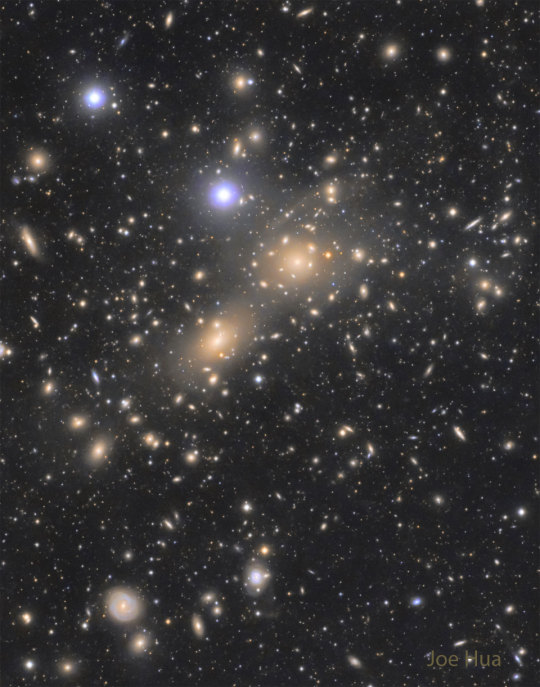
2024 March 27
The Coma Cluster of Galaxies Image Credit & Copyright: Joe Hua
Explanation: Almost every object in the featured photograph is a galaxy. The Coma Cluster of Galaxies pictured here is one of the densest clusters known - it contains thousands of galaxies. Each of these galaxies houses billions of stars - just as our own Milky Way Galaxy does. Although nearby when compared to most other clusters, light from the Coma Cluster still takes hundreds of millions of years to reach us. In fact, the Coma Cluster is so big it takes light millions of years just to go from one side to the other. Most galaxies in Coma and other clusters are ellipticals, while most galaxies outside of clusters are spirals. The nature of Coma's X-ray emission is still being investigated.
∞ Source: apod.nasa.gov/apod/ap240327.html
80 notes
·
View notes
Text
The search for dark matter
Post #6 on Physics and Astronomy, 06/10/23
Welcome back.
This time, I’m going to be talking about how astronomers and physicists have made an effort to detect and provide evidence for the existence of dark matter.
To recap from my first issue, it’s worth talking about what dark matter actually is. It’s a type of matter estimated to make up about 80% of the Universe’s matter. To date, it hasn’t been detected. Light passes straight through, it is assumed, however we infer the existence of such a substance due to its gravitational influence.
We can take an example from the Bullet Cluster. This is a pair of galaxy clusters that collided head-on a while ago. That pink mist you see in the photo is hot gas, and within it most of the regular matter. The blue mist, on the other hand, is dark matter, and where most of the mass of these two galaxies were in this photo.
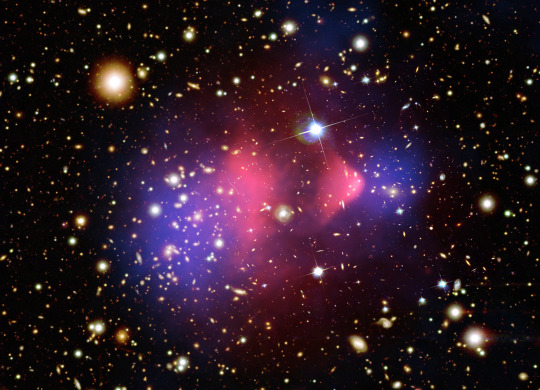
Vera Rubin and Kent Ford
Vera Rubin and Kent Ford were two astronomers who had worked together to observe the Andromeda Galaxy, more specifically the rotational velocities of concentric regions from the center. The prediction was that, the further you looked from the center, the less the velocity of the stars within that region, since a greater centripetal force would be required to maintain a high-velocity orbit. This, however, was not the case.
It was observed that the velocity remained nearly constant the further you went out. Wait a minute, though, this didn’t make sense–that velocity was high enough, in theory, to make the stars fly off into space. But they weren’t.
These findings matched those of Fritz Zwicky. He was a Swiss astronomer who had studied the Coma galaxy cluster. He made the same observation–the speeds were so high that the stars should just have been flung off into space. His findings, however, were ignored.
Experiments to detect dark matter
So far, experiments to detect dark matter have been largely unsuccessful. Some of these include PICASSO, LUX-ZEPLIN, EURECA, FUNK, KIMS, DarkSide, Edelweiss, DARWIN, and DAMA/LIBRA, which is what I’m exploring next.
This detector in particular, introduced promising results which ended up the subject of dispute. DAMA/LIBRA, which hoped to capture activity from WIMPs (Weakly Interacting Massive Particles), returned a signal with a period of one year. This looked to be one step closer to affirming dark matter’s existence–however, COSINE-100, an experiment set up to mirror that of DAMA/LIBRA, could not reach those same results, which led to the belief that the signal detected could be from some other factor.
The search for dark matter is one that interests me very much. It’s like telling someone in the Stone Age that metal exists, and they should go find it. Except, dark matter is seemingly even more impossible to find, since we can’t perceive it, with the human eye or the best of our current technology. Which, I guess you could argue, would be exactly how the Stone Age person would have felt, but you understand my point.
That said, it’s something I’m eagerly watching. The day we find something promising? You’ll hear it first from me.
#physics#studyblr#astronomy#engineering#astrophysics#stem#sixth form#alevels#dark matter#dark energy#mathematics#physicsblr#mathsblr
50 notes
·
View notes